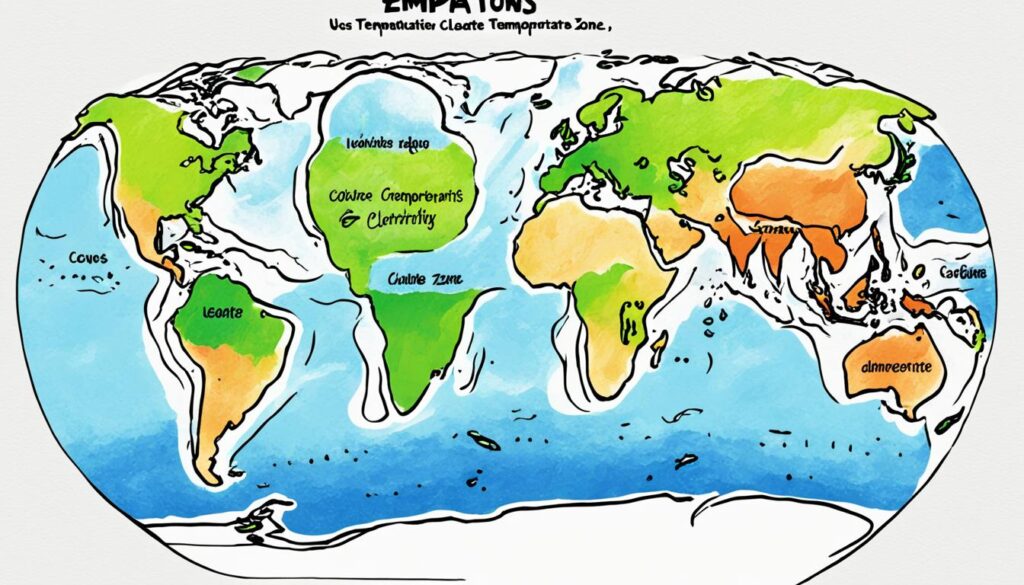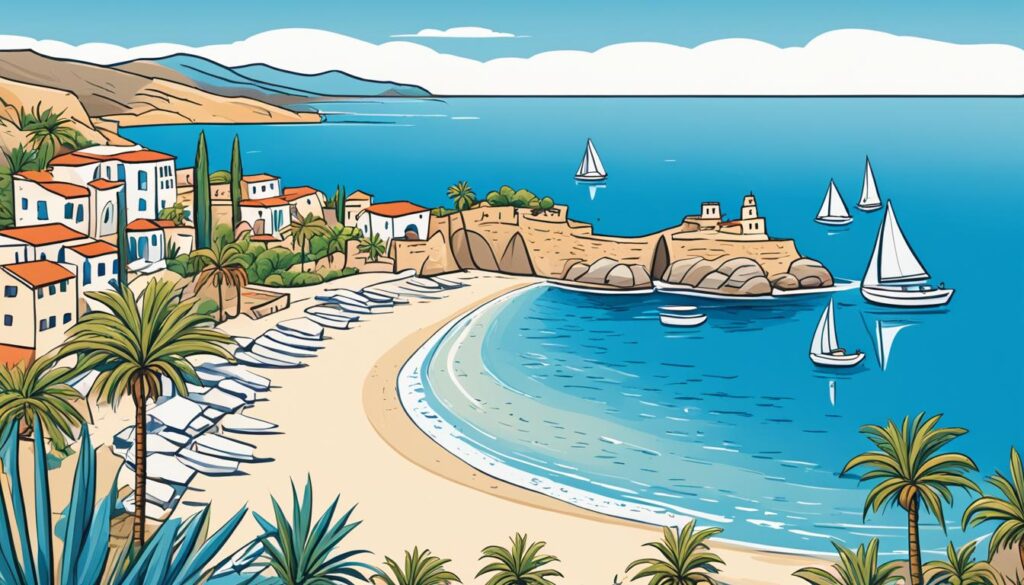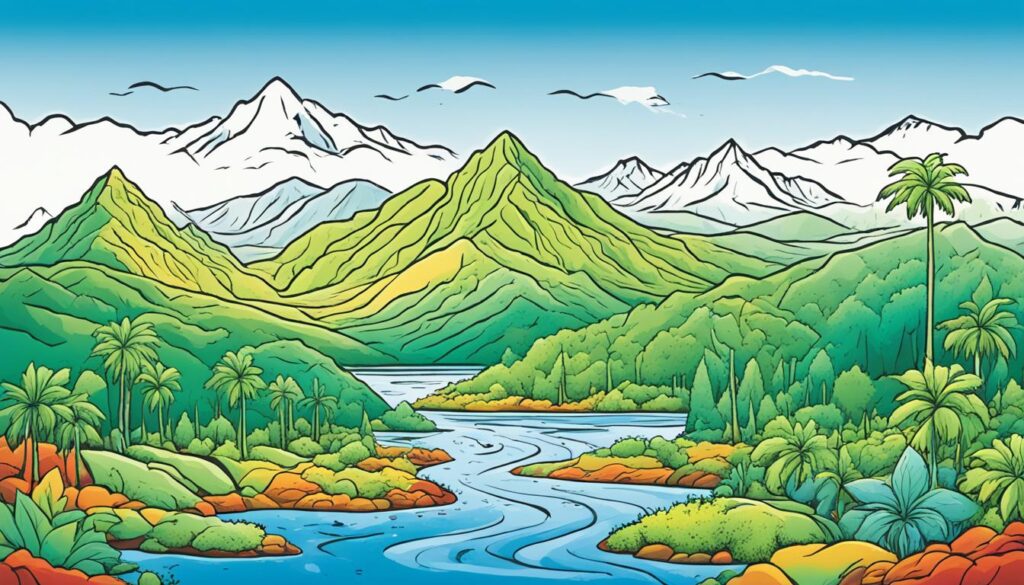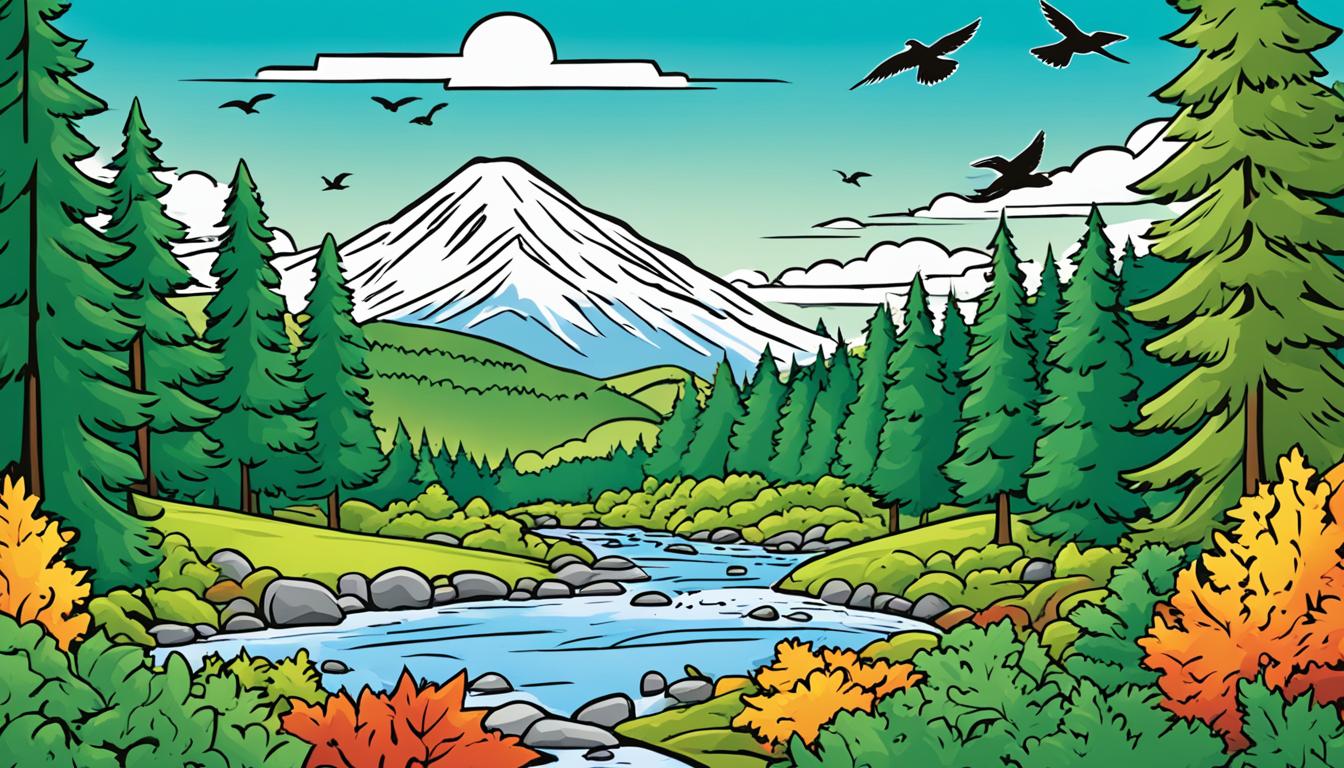The temperate zones stretch from the Tropic of Cancer to the Arctic Circle. They also reach from the Tropic of Capricorn to the Antarctic Circle. These areas cover a big part of Earth and have mild weather and moderate temperatures. This makes them ideal for living. The reason? They lie between 23.5° to 66.5° N/S of the Equator. This location is just right – not too hot like the tropics, but not too cold like the poles.
The Köppen climate classification calls these places ‘temperate climate’ ‘C’. The coldest month’s average temperature is between -3 °C and 18 °C. This pleasant climate is found in North America, Europe, and Asia. It brings four beautiful seasons. There’s the warmth of summer and the cool of winter. Each season makes a picture-perfect moment in a temperate region.
Key Takeaways
- Temperate climates occupy a vast area extending from the tropics to the polar circles.
- The Köppen climate classification is fundamental in defining what constitutes a temperate climate.
- Temperate regions are preferred for their moderate temperatures and desirable living conditions.
- Geographical variety means temperate climates offer a diverse range of weather experiences.
- Climates in the temperate zone promote biodiversity and dense human populations.
- Climate change is expected to shift and perhaps expand the borders of temperate zones.
The Essence of Temperate Climates
The definition of temperate climate is vital when looking at Earth’s areas. Temperate climates are mild, according to the Köppen climate classification. They keep temperatures above -3°C (26.6°F) but below 18°C (64.4°F). This balance makes these zones great for large human populations, unlike other climatic regions.
Defining a Temperate Climate
The temperate climate characteristics show an environment free from harsh weather. Summers are warm, and winters are cooler. This setting promotes a rich variety of life.
Global Distribution of Temperate Climates
These climates cover Earth’s middle latitudes, across continents, from 40 to 60 degrees north and south of the Equator. They extend over North America, Europe, eastern Asia, South America, and Australia. Each place is unique, sharing a common climate classification. These areas boast immense biodiversity and high human development levels.
Characteristics of Temperate Climate
The temperate climate covers areas from the Mediterranean Basin’s lush vineyards to New England’s vibrant autumn leaves. These regions enjoy a moderate climate. This makes temperate areas popular for nature and people.
Seasonal Variations and Temperature Dynamics
Temperate zones experience a fascinating change in seasons due to the Earth’s tilt and orbit around the sun. From hot summers to cold winters, the weather changes distinctly.
This results in diverse seasonal experiences. For example, Chicago transforms from summer celebrations to winter landscapes.

Impact of Geographical Factors
Geography plays a big role in a region’s climate. Factors like being close to the sea affect temperature and air moisture. Winds also move heat and rain around, creating different climates.
Sometimes, these conditions create climates with big temperature changes. High places, though, may stay mild compared to tropical areas.
| Climate Zone | Defining Characteristics | Geographic Example |
|---|---|---|
| Oceanic | Mild temperatures, consistent precipitation | Northwestern Europe |
| Humid Continental | Large seasonal temperature variation | North American Midwest |
| Subpolar Oceanic | Milder winters, less extreme temperatures | Coastal Iceland |
| Subtropical Highland | Mild year-round temperatures, distinctive seasons | Andean highlands |
| Mediterranean | Dry summers, wet winters | Mediterranean Basin |
| Humid Subtropical | Hot, humid summers, frequent showers | Southeast China |
From southeastern Australia’s hills to the North Atlantic’s cold winds, the temperate climate tells stories of nature. It’s known for hosting the most livable and farmable places on Earth.
Exploring Köppen’s Climate Classification
The Köppen climate classification helps us understand the world’s climate zones. It uses temperature and rainfall to map biodiversity. Studying over 26,000 types of animals has revealed a new view, showing that climate regions are more complex than we thought.
The Köppen system breaks climates into five main groups: Tropical (A), Dry (B), Temperate (C), Continental (D), and Polar (E). These groups help us recognize climate patterns worldwide. This system is beneficial in temperate zones, helping with ecological studies.
Recent studies have found 16 different climate regions, including vibrant rainforests and quiet tundras. The way plants and animals spread out in these areas shows a complex relationship with climate that goes beyond simple categories.
The ‘C’ group stands for temperate climates, which are common in human environments and marked by mild temperatures. The ‘D’ group, or Continental climates, have more extreme weather, especially in winter.
- Mid-level energy and high rainfall climate regions exhibit significant species richness.
- Similar climate zones tend to maintain similar populations of tetrapods.
- Tropical and Dry climates zones A and B, cover specific latitudes with distinct temperature and precipitation thresholds.
The Köppen system was great initially but needs updating to reflect biological diversity better. This means we should see climate classification as something that grows with our knowledge of ecosystems.
Today, variables like water and energy help us go beyond old climate categories. Continental and dry climates cover a vast part of Earth, showing how widely the Köppen system applies.
Scientists are updating the Köppen model to keep up with our changing climate, ensuring it stays relevant. The Köppen maps are still key references, reflecting our evolving understanding of the climate.
The Köppen climate classification remains crucial for studying climate. It helps us appreciate the diverse climates that make our planet lively and habitable.
Zones Within the Temperate Climate

The vast lands of temperate climate zones are full of different weather patterns, rich plant and animal life, and special features. They stretch from regions that enjoy warm subtropical weather to areas with cooler climates. According to the Köppen system, a temperate C climate is defined by the coldest month’s mean temperature, which falls between −3 °C (26.6 °F) and 18 °C (64.4 °F).
The north temperate zone lies between the Tropic of Cancer and the Arctic Circle, while its southern counterpart extends from the Tropic of Capricorn to the Antarctic Circle. These areas are known for their various microclimates and distinct seasonal changes. Mediterranean climates are famous for dry summers and wet winters on the continents’ western sides. On the other hand, oceanic climates offer a balance with consistent humidity and precipitation throughout the year.
- Humid continental zones witness a stark contrast between hot summers and cold winters, shaped by the large lands and winds.
- Meanwhile, subpolar oceanic climates show a gentler side, with less extreme temperature changes. Such climates can be found in beautiful coastal Iceland and the green Faroe Islands.
The different climates shape the land and the plant and animal life that cover it. This makes the temperate climate zones a haven for diverse species, all adapted to subtropical areas or cooler spots. By learning about these climates, we get a better picture of our planet’s climate pattern and understand more about where we fit in this vast and colorful world.
Understanding the Subtropical Zones
Subtropical regions mix warm tropic weather with temperate zone traits, creating a comfortable and pleasant climate. These areas range from 23.5° to 35° near the equator. Due to their close location to the equator, they show a varied climate. This unique position leads to different weather areas, boosting biodiversity and places to live.
Climate Influence of the Tropics
Tropical climates greatly affect subtropical regions, which receive year-round warm weather. These zones receive the outer edges of tropical air, giving them long, warm summers and short, mild winters. This allows many plants and animals to thrive, making these areas rich in ecology and life. Their mild climate and tropical warmth make them great for people.
Variations in Subtropical Weather Conditions
Subtropical zones experience a wide range of weather. Humid subtropical climates, often found along eastern coasts, have hot, humid summers and mild winters. On the other hand, Mediterranean climates, common on western continents’ borders, offer dry summers and wet winters. This variety happens as these climates link equatorial moisture with arid desert air.
| Climate Feature | Subtropical Region | Comparison Zone |
|---|---|---|
| Avg. Temperature Threshold (Coldest Month) | Greater than 27°F (-3°C) | Less than 27°F (-3°C) in Moist Continental Mid-Latitude Climates |
| Latitude Range | 30°-50° | 20°-35° North and South (Dry Climates) |
| Notable Climatic Influence | Tropical | Polar (In Polar Climates) |
| Rainfall Pattern | Varies; Often more even distribution | Tropical rainforest: Over 60mm every month |
The Köppen-Geiger system helps us understand subtropical climates within wider weather zones. It was started by Wladimir Köppen and refined by Rudolf Geiger. It uses specific temperature and rainfall criteria to define climates. Subtropical climates are known for moderate-to-high temperatures and varied rainfall.
Changes are happening in subtropical climates, with warmer winters in California and Florida. This shows a shift in climate, suggesting a stronger tropical influence. It might also change temperate zones.
Temperate Climate: Humid Subtropical Region
Humid subtropical regions have moderate temperatures all year and a comfy climate. Places like the southeastern U.S., southeastern Asia, South Africa, and Australia show this off best. They offer a gentle escape that stays away from hot or cold weather.
Features of Humid Subtropical at a Glance
These areas have long, humid summers with thunderstorms. The winters are mild and hardly ever freeze. Warm ocean currents make the climate nice for people and plants.
Regions such as Georgia and the Carolinas in the United States, along with similar latitudes worldwide, represent this pleasant harmony of weather patterns where temperate climate vegetation flourishes backed by sufficient rainfall and warmth.
Distinct Weather Patterns in Humid Subtropical Regions
The weather patterns here match beautifully with life’s rhythm. Monsoons bring a change from dry winters to rainy summers, which helps farming and biodiversity and offers a vivid look at life adapted to these climates.

The Köppen system puts these areas as ‘Cfa’ and ‘Cwa’. This sets them apart from tropical wet and dry climates. It also links them to monsoon patterns seen in Asia and Africa. Below, you can see the variety of climate types and their main traits:
| Climate Type | Temperature Range | Key Features | |
|---|---|---|---|
| Mediterranean (Csa, Csb) | 0 °C | 18 °C | Dry summers, mild, wet winters |
| Humid Subtropical (Cfa, Cwa) | Year-round moderate temperatures | Long humid summers, mild winters | |
| Tropical Monsoon (Am) | 24°C – 28°C | Rainfall with seasonal wind reversal | |
| Tropical Wet & Dry (Aw, As) | Relative humidity 55% – 80% | Three distinct seasons, including a hot, wet season | |
| Microthermal | Cold winters | Regions such as Boston, southern Scandinavia | |
| Megathermal | Hot and Humid | Includes the Amazon Basin, islands in Southeast Asia | |
Warm ocean currents mesh well with seasonal changes, keeping temperatures moderate in humid subtropical zones. This balance is seen in how rain and plant life cycle together, maintaining harmony between humans and nature.
Mediterranean Climates: A Temperate Phenomenon
The Mediterranean climate is a part of temperate regions. It has clear blue skies and beautiful landscapes. This climate offers the best living conditions, making it a top choice for tourists and residents.

Geographical Areas with Mediterranean Influences
Areas with a Mediterranean climate are precious in temperate zones. They include the Mediterranean Basin, coastal California, and Western Australia. These places offer a high quality of life and leisure.
Summer Dryness and Winter Rainfall Characteristics
The Mediterranean climate is unique, with dry summers and mild winter rain. This allows olives, grapes, and many other crops to grow and creates a beautiful landscape of green shades.
| Climate Type | Summer Season | Winter Season |
|---|---|---|
| Mediterranean | Dry and Warm/Hot | Wet and Mild |
| Dry Climates | Very Dry and Hot | Varies (often still dry) |
| Moist Sub-tropical Mid-latitude | Warm/Cool and Humid | Mild |
| Moist Continental Mid-latitude | Warm to Cool | Cold Winters |
| Polar Climates | Cold | Colder |
| Highland Climates | Varies with Elevation | Varies with Elevation |
This balance of sunshine and seasonal rains supports life. It creates a habitat that pleases people and supports diverse plants and animals. It shows the beauty of life in Mediterranean climates.
Highland Climates in Subtropical Regions
Subtropical highland climates mix highland climates with temperate climates, thanks to altitude influence. People study these areas for their unique climate, which is different from the warm lowlands. They’re known for their moderate weather conditions.

Altitude’s Role in Temperate Weather Conditions
Subtropical highlands are special for their weather. Altitude influence keeps temperatures between 12°C and 19°C all year. Unlike sea-level climates, they have their weather patterns.
Here, day and night temperatures can vary by 10°C. This shows altitude’s big role in climate.
Rainfall in these areas is also interesting. It ranges from 700mm to 2000mm a year. Depending on the place, rain can be steady or come in monsoon bursts, creating unique environments for temperate climate plants.
The highland equatorial climate (Csbi) shows a special pattern. Rainfall decreases by about 100mm with every 100m rise in altitude. This tight link between altitude and rain creates diverse ecosystems.
Highland subtropical climates help us see the bigger climate classification picture. They blend altitude with temperate zones, which doesn’t fit neatly into just one classification. These areas show how altitude affects local weather.
In short, subtropical highlands shield us from extreme weather. They show how altitude influences the shape of moderate weather conditions. These regions highlight the importance of temperature and rainfall in our world’s climate variety.
Climates of the Middle Latitude Zones
The middle latitude zones are areas with a mix of climates shaped by both tropical and polar air. These zones have seasonal variations, with a wide range of average temperatures and weather patterns. This variety supports different ecosystems and human cultures.
In these zones, there’s a big difference between continental and oceanic climates. The continental climate has dramatic seasons because it’s landlocked. Summers can reach above 50°F, and winters can drop below 27°F.
The oceanic climate, however, has the ocean close by. This means its weather is milder throughout the year. It gets temperate conditions.
For more information, visit the National Oceanic and Atmospheric Administration. They offer deep insights on how these climates affect our planet.
The middle latitude zones are crucial for studying the Earth’s climate. The seasonal variations here impact local environments and the global weather. This information is vital for weather science and climate study.
- Moist subtropical mid-latitude climates, nestled between 30°-50° latitudes, revel in warm summers moderated by convective thunderstorms.
- Conversely, moist continental mid-latitude climates situated poleward brace for cold winters while enjoying warm summers.
- Although colder across seasons, polar climates are also considered part of the middle latitude spectrum due to their geographical positioning in the northern realms.
- The zone’s diversity is further amplified by the highlands, where fluctuations in elevation translate to rapid microclimatic shifts.
The average temperature changes make the middle latitude zones special. They go from the cold of the polar areas to warm, humid subtropical places. These changes affect the weather. They also influence the plants, animals, and people living there. Each unique latitude shows how complex and rich the Earth’s climate is.
In short, the middle latitude zones blend hot and cold, wet and dry. They have both continental and oceanic climates. Here, you can see many kinds of temperate weather conditions. This mix shows how diverse and complex our Earth’s climate can be.
Oceanic Climates: Mild and Moist Year Round
Oceanic climates are known for their year-round moderate temperatures and steady moisture. These areas showcase a comfortable climate, never too hot in summer or too cold in winter.
This climate is found in places like northwestern Europe and parts of the Pacific Northwest in North America. These areas get a constant flow of marine air, which results in an even amount of rain all year, supporting lush greenery and lots of wildlife.
Regions with Oceanic Influences
Areas with temperate zone characteristics have unique weather patterns. The ocean keeps temperatures mild in southeastern Australia and New Zealand. Summers are cool, and winters are gentle, making the weather pleasant all year.
The Balance of Precipitation in Oceanic Climates
In oceanic climates, seasons are defined by how much rain rains rather than how hot or cold it is. This consistent weather and moderate temperatures allow plants and animals to flourish. They don’t face harsh conditions that exist in other climates.
The Rigors of Humid Continental Climates
The humid continental climate stands out in temperate zones for its big seasonal changes. Large land areas heavily influence it. This results in a mix of severe weather events within its four-season patterns. Also, it switches from cold winters to hot summers. This difference gives it a special appeal, especially for those who love the change in seasons.
Places like southeastern Canada, the eastern U.S., and areas in eastern Europe and Asia have this climate. These climate zones show the beauty of four-season patterns, changing from green springs to golden autumns. These climate zones give us a range of weather, from calm to extreme storms. They leave a mark in our history and memories.
For 2022, data from the U.S. highlight this climate’s ups and downs. Florida and Rhode Island were among the top warmest. Massachusetts was closely behind. Texas saw record heat from April to July, showing how hot it can get.
| Statistic | Data | Context |
|---|---|---|
| Avg. Annual Temperature (2022) | 53.4°F | 1.4°F above 20th-century average |
| Avg. Max Temperature (2022) | 65.7°F | 14th warmest on record |
| Avg. Min Temperature (2022) | 41.1°F | In the warmest third of the record |
| Avg. Annual Precipitation (2022) | 28.35 inches | 1.59 inches below average |
| Heat Records Broken (Early Sep 2022) | Nearly 1,000 | Reflective of severe weather potential |
The year 2022 showed how humid continental climates can flip between extremes. For instance, warm records outnumbered cool ones significantly. Nebraska and California saw much less rain than usual. This highlights the unpredictability of these climate zones.
The U.S. faced 18 major weather-related disasters in 2022. Each caused damages of over $1 billion. Hurricane Ian alone cost about $112.9 billion. This shows the powerful impact such climates can have on us.
The Subpolar Zone: The Cool Extent of Temperate Climates
The subpolar zone sits at the edge of the Arctic and Antarctic circles. It blends the cold polar air with a milder temperate climate. This creates a unique, non-extreme climate with four seasons. This zone includes places like Iceland’s coasts and Scotland’s highlands. They have cooler weather all year round. Their summers and winters are milder compared to the extreme polar regions.
The subpolar zone has a more moderate climate than its neighbors. Its winters are not too cold, and summers are cool, not hot. This area gets more snow, showing its link to the poles.
Tropical and dry climates are hot or arid. But, the subpolar regions offer a middle ground. They are less extreme and often more comfortable. Below, you can compare the key features of different climates, including the subpolar zone.
| Climate Zone | Temperature and Precipitation | Distinguishing Characteristics |
|---|---|---|
| Moist Tropical | All months > 64°F (18°C) Annual precipitation > 59″ | Heat and humidity year-round |
| Dry | Evaporation > Precipitation 20°-35° N/S | Arid landscapes, scarce rainfall |
| Moist Subtropical Mid-Latitude | 30°-50° latitude Warm summers, mild winters | Convection thunderstorms prevalent |
| Moist Continental Mid-Latitude | Warm/cool summers, cold winters Snowstorms and bitter cold are possible | Presents a true four-season cycle |
| Polar | Year-round < 50°F (10°C) | Endless winters, brief mild summers |
| Subpolar Oceanic | Cool year-round, moderate winters | Non-extreme climate with more snowfall |
The subpolar zone stands out with its temperate qualities. It’s a cool area that links extreme cold and milder climates. This zone deserves more attention for its unique climate balance.
Temperate Climates at the Verge of the Poles
In the far reaches of the temperate zone, temperate-climate countries are at the edge where mild climates start to face the colder Arctic circles. The climate here is influenced by both the location and complex atmospheric behaviors. To understand this better, we can look at climate classification and discover how air circulation and temperature changes work.
In such areas, average temperatures vary slightly through the year, showing the typical four-season pattern of temperate zones. This climate is a clear example of nature’s balance, even near the cold ends of our planet.
The role of prevailing winds in shaping temperate climate areas is intriguing. Earth’s spin and the Coriolis effect influence these winds. They include polar easterlies, prevailing westerlies, and northeast trade winds, which mix in a complicated way across latitudes.
- Hadley, Ferrel, and Polar cells are key in this atmospheric dance, each with a crucial role in global circulation.
- Winds change due to friction on the ground. This alters their speed and direction, moving toward low-pressure areas and adding variety to climate classifications worldwide.
- Landforms like mountains and water bodies bring local changes to these wind patterns, significantly impacting weather patterns.
| Wind Type | Influence on Temperature | Effect on Local Weather Patterns |
|---|---|---|
| Land and Sea Breezes | Temperature contrast between land and water | Helps moderate climate in coastal places |
| Mountain Winds | Differences in elevation | Causes katabatic and anabatic winds |
| Mountain Wave Phenomenon | Air moving over high land | Creates strong waves and unique clouds |
Land and sea breezes happen because land and ocean temperatures differ, affecting coastal regions in temperate climate countries. Mountains have their special weather, with strong winds and turbulence. Winds called katabatic and anabatic are common in these areas, and the mountain wave is seen when air goes over mountains, causing significant waves and cloud patterns that are challenging for pilots.
The intensity of mountain waves depends on wind speed, how the wind hits the mountains, and the air’s stability. These constant factors create a varied and moderate climate near the poles.
Year-Round Moderate Temperatures in Temperate Regions
Temperate regions offer year-round moderate temperatures and consistent weather patterns, which make them great for living. Key systems, which show diverse weather effects, make it easier to understand how these climates work.
C.W. Thornthwaite introduced a way to sort climates in 1948. It looks at water use and evaporation. With this, we learn about microthermal, mesothermal, and megathermal climates. It helps us understand climates from cool to warm areas.
Mesothermal regions have the ideal temperate climate cities. They have pleasant weather and clear seasons. Places like the Mediterranean and coastal Australia have this climate. They are known for their temperate beauty.
Consistent Weather Patterns and Livability
Looking deeper into the Köppen system, we see temperate zones are ‘mild.’ This makes them great for many activities like farming and tourism. Even renewable energy grows here. This shows how industries can do well in different weather conditions.
Examples of Cities with Ideal Temperate Conditions
Cities like San Francisco, Madrid, and Melbourne have perfect temperate conditions. These cities blend nature and city life well. They enjoy consistent weather patterns that help the economy and fun activities. Getting to know these cities shows how nicely people can live with nature, thanks to a temperate climate.
Vegetation and Biodiversity in Temperate Zones
The temperate climate vegetation shows how well plants and animals have adapted. They have evolved to survive the big seasonal changes in these areas. This has led to a wide variety of life in biodiversity in temperate zones, where each species has its special role throughout the changing seasons.
Temperate climate plants are tough. For instance, deciduous trees lose their leaves in winter to save water. They then come back to life in spring when the weather is better. This shows how plants have adapted to survive in these climates.
Plants are crucial for the animals living there, providing them with homes and food. This creates a balanced ecosystem that adjusts to the local climate. Birds, for example, move with the seasons, following the food available in temperate summers and leaving when it gets cold.
Adaptation of Flora to Seasonal Changes
Temperate areas support many layers of life. From the ground to the treetops, many species have evolved. They’re influenced by sunlight, soil, and moisture, which change with the seasons. The types of plants that grow there match up with things like the climate, soil, and habitat type.
Areas with plants in temperate zones don’t get as hot or cold as places without much vegetation, like cities. The greenery helps keep the local climate steady, which is why we should protect these natural areas.
| Climate Zone | Characteristics | Vegetation Features |
|---|---|---|
| Mediterranean | Dry summers, mild, wet winters | Hard-leaved evergreens, woody shrubs |
| Tundra | Cold, short growing seasons | Mosses, lichens, dwarf shrubs |
| General Temperate | Distinct dry season, moderate max temperatures | Deciduous and evergreen forests |
When discussing climate change, it’s important to note that changing climates will impact the vegetation in temperate zones. This means we must understand and save the variety and roles of temperate ecosystems. This is key to making them strong against changes in the environment.
Final Thoughts
When considering all the information on global ecosystems, temperate climates really stand out. They range from subtropical to nearly polar areas. These zones have mild weather and changing seasons, which help many different life forms thrive. These areas are also super important for many people around the world. They have big farms and contribute greatly to the world’s food and economy.
Temperate rainforests aren’t as harsh as tropical ones and have many unique lives. While tropical areas can have many weather changes and climate issues, temperate zones are more stable. This stability is great for growing plants, storing carbon, and making oxygen. It helps farming too and keeps forests healthy for a long time.
It’s vital to understand how valuable temperate climates are. They offer great places to live and are key to the earth’s health. As we see more environmental challenges, protecting these areas becomes even more critical. They’re not just homes for countless species but also protect our climate. That’s why we must take good care of them, for all our lives rely on these unique environments.
FAQ
What Defines a Temperate Climate?
Where are Temperate Climates Found?
How do Geography and Location Affect Temperate Climates?
What is the Köppen Climate Classification, and How Does it Categorize Temperate Climates?
What are the Subtropical Climates, and How are They Different from other Temperate Climates?
How do Altitude and High Elevation Influence Temperate Climates in Subtropical Regions?
What Distinguishes Oceanic Climates within Temperate Zones?
What Sets Humid Continental Climates Apart from Other Temperate Climates?
What are the Characteristic Weather Patterns of Cities with Ideal Temperate Climates?
How Does Vegetation Adapt to the Seasonal Changes in Temperate Climates?
Source Links
- https://www.noaa.gov/jetstream/global/climate-zones
- https://en.wikipedia.org/wiki/Temperate_climate
- https://www.metoffice.gov.uk/weather/climate/climate-explained/climate-zones
- https://climate.nasa.gov/news/2953/nasa-finds-what-a-difference-a-degree-makes/
- https://www.ncbi.nlm.nih.gov/pmc/articles/PMC7963472/
- https://earthhow.com/koppen-climate-classification/
- https://www.nationalgeographic.org/encyclopedia/koppen-climate-classification-system/
- https://www.usgs.gov/news/national-news-release/parts-uss-southernmost-states-will-tropicalize-climate-changes
- https://www.nationalgeographic.org/article/all-about-climate/
- https://www.ncbi.nlm.nih.gov/pmc/articles/PMC10306175/
- https://en.wikipedia.org/wiki/Highland_temperate_climate
- https://encyclopedia.pub/entry/33424
- https://www.ncei.noaa.gov/access/monitoring/monthly-report/national/202213
- https://www.energy.gov/eere/buildings/climate-zones
- https://www.weather.gov/source/zhu/ZHU_Training_Page/winds/Wx_Terms/Flight_Environment.htm
- https://typeset.io/questions/what-are-some-of-the-common-plants-and-animals-found-in-44km7j8tsf
- http://www.ciesin.columbia.edu/docs/004-145/004-145.html
- https://www.nature.com/articles/s41598-019-51221-w
- https://fundtheplanet.net/rainforest-conservation/exploring-the-differences-between-temperate-and-tropical-rainforests/
